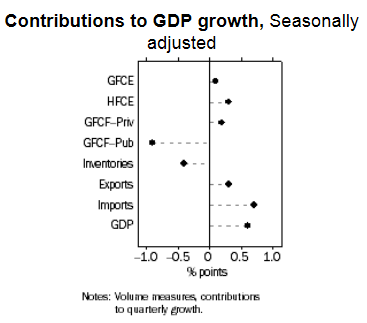
Suddenly an Australian recession is not such a shocking idea to the MSM. Today’s press is full of recession hand-wringing and for good reason. Yesterday’s GDP figures painted a worrying picture of an RBA that is behind the curve. Of fiscal settings that are wildly inappropriate. Of a dollar in outer space. And of a country that has very limited desire to follow the rebalancing path set before it by the same elites that have stuffed our macro settings.
At The Australian, David Uren focuses on the WA recession, twice, and reckons we’re in for a “recession election“:
Mr Haslem said the national accounts reflected an economy “lacking animal spirits”, despite the boost from rate cuts over the past 18 months. Western Australia shows the change in national outlook. It has been the national powerhouse over the past decade, averaging annual growth rates of almost 8 per cent.
But in the latest quarter, state final demand – the partial measure of state economic growth contained in the national accounts – fell 3.9 per cent following a 0.9 per cent drop the previous month. Western Australia’s slide wiped 0.6 percentage points off the domestic economy in the past year.
…Macquarie Group senior economist Brian Redican warned the national economy had managed an annual growth rate of only 2.25 per cent in the past six months.
So could mining exports be the economy’s saviour in coming years, taking over the baton from mining investment? If Australia were the only producer on the planet, and China’s demand kept swelling at its old rates, yes. But in the real world, the Bureau of Resources and Energy Economics forecasts mining export volumes to average 5 per cent growth. That won’t match the size of the likely fall in mining investment, or provide many jobs.
And as I’ve chronicled for some time, BREE is an optimist.
Meanwhile at the AFR, the political idiocy of Wayne Swan’s op-ed yesterday has freed it to go hog wild. From the editorial:
This is the 2013 “growth gap” foreshadowed by Reserve Bank governor Glenn Stevens in his interview with The Australian Financial Review late last year. The economy is looking for new sources of growth as the massive wave of resource development peaks before turning down in the next year or so. The high dollar and the economy’s inflated cost base continue to bear down on non-mining business. Households remain cautious about spending as they rein in their debts. Canberra can’t help because Mr Swan has blown the budget. The Reserve Bank has cut its cash rate to a record low 2.75 per cent. But interest rate sensitive industries, such as housing construction are proving slow to react. That leaves the economy relying on the bright spot of solid export growth to keep the place ticking over.
Actually, growth is in part lousy because Swan is overly concerned with repairing the Budget but let that pass. Also at the AFR, the former ‘net exports will save us’, Geoff Carmody has been macrobated:
Falling terms of trade and a depreciating $A convey the same policy message. Falling terms of trade mean the world is imposing cuts to our national income. Our recession in terms of real, per capita, net national disposable income has been running unbroken for 15 months now. Martin Ferguson noted we must grow our pie before we can distribute it. Our slices of pie, on average, are shrinking.
A depreciating $A is no ‘free lunch’ either. It can improve our international competitiveness.
This requires export prices to fall in foreign currency terms (even if they rise in $A terms). Import prices must increase in $A terms. Local price effects of depreciation must not be allowed to flow onto higher wage and price inflation.
Real incomes must be shaved, or at least grow less. Otherwise, the competitive gains from depreciation won’t last.
Falling terms of trade and a weaker $A are telling us it’s well past time the policy switches are flipped more decisively from punchbowl to prudence and productivity.
Meanwhile, Alan Mitchell does a two-step backwards for more rate cuts and Max Walsh quite rightly describes the poisoned chalice that is an election win (with apologies to the Kouk):
The political consensus is that Tony Abbott will not only win the election on September 14, but that he will do so in a landslide that will ensure the Coalition of two or more parliamentary terms.
I wouldn’t bet on that longevity.
To read recent speeches by two of our most distinguished economists, Treasury secretary Martin Parkinson and corporate high-flyer and academic Ross Garnaut, is to appreciate that, after a world-breaking run of growth, Australia is at an inflection point.
If their prognostications are correct, it may well turn out that Australia did not dodge the brunt of the global financial crisis but merely postponed it.
In case you haven’t noticed, this is the most blue-chip line-up of Australian economic commentary available. Slowly they are catching on: the RBA is behind the curve; fiscal austerity at this point is insane and households will not be able pick up the slack. Nor, in fact, should they.
It will be interesting to see if this discussion passes. I think it likely. The AFR was happy to make Wayne Swan the butt of a joke today but it will not serve its agenda of electing an austerity-wedded LNP if we’re all talking about recession.
But there is only so much that bias can hide. The balance of risks confronting the June quarter National Accounts released on July 27th are heavily tilted to the downside. Check out the below GDP mix for March:
For the June QTR, Government Final Consumption Expenditure will likely still be weak on austerity. Household Final Consumption Expenditure may be negative as consumers wound right back from the first quarter post-Christmas binge. Growth in Private Gross Fixed Capital Formation will likely be subdued at best with all surveys showing weak cross-sectoral capex intentions. Public Gross Fixed Capital Formation may not be as weak as the March QTR but is unlikely to boom on spending cuts. Inventories appear to be still falling on weak demand, though perhaps not as far in the second quarter. Net exports will likely detract from growth in the second quarter as the iron ore and coal restock cycles passed in April (though perhaps more import falls will help). Add to this that national income and wages will all be under pressure from the Q2 iron ore flogging.
It’s possible we’ll see a negative print on the quarter and probable that it will be significantly lower than June 2012’s 0.6 meaning the annual number will fall closer to 2%.
More important, though, is the lesson offered here for the next three years. When investment falls, it is a very difficult drag on growth to overcome. The net exports, housing and consumption rebalancing that has been laid out by our elite is not working. Net exports support quantitative measures but do not create real economic activity (the investment is already done, the profits flow overseas, there is some tax pickup). To boost activity, either the government or private sector must spend or invest more. Business investment will fall on mining. Consumers rightly want to save and should be encouraged to because they are still overstretched with incomes under pressure, which will continue as the terms of trade keep falling.
Some spending growth can be expected to happen as house prices slowly rise but not enough. And if its not enough then the risk is rising unemployment will drag down the consumer as well.
The way forward is plainly obvious. Stop relaying so heavily on households. Create a plan of moderate public capital investment aimed at productivity enhancing infrastructure that satisfies the constraints of the ratings agencies, get on with productivity reform and lower the dollar any way you can. The best way is cut interest rates until the it falls. If house prices get too bubbly then use macroprudential tools, such as those being used now in New Zealand, to control credit. The falling dollar will add to growth by boosting non-mining (and mining) tradables investment.
And hurry up about it.


